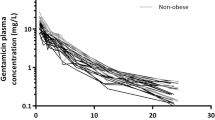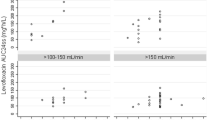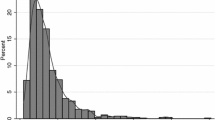Abstract
Background
Linezolid is an anti-Gram-positive antimicrobial agent used at a fixed dose of 600 mg every 12 h.
Objectives
The objective of this study was to assess the population pharmacokinetics and pharmacodynamics of linezolid in a retrospective cohort of overweight and obese hospitalized patients.
Patients and Methods
Population pharmacokinetic and Monte Carlo simulations were conducted to assess the probability of target attainment (PTA) of an area under the concentration–time curve from time zero to 24 h (AUC24)/minimum inhibitory concentration (MIC) ratio > 100, defined as the pharmacodynamic target of efficacy, with incremental candidate dosages. Maximum permissible doses were defined as those causing a ≤ 25% of probability of a linezolid trough of > 8.06 mg/L, associated with thrombocytopenia. The cumulative fraction of response was calculated for the permissible linezolid doses by testing the PTA against the MIC distributions of a large collection of Staphylococci and Enterococci.
Results
A total of 352 trough (minimum) and 293 peak (maximum) linezolid concentrations from 112 patients were included. The final mixed-saturative model accounted for 88% of drug concentrations variability over time, and estimated creatinine clearance [by means of the Chronic Kidney Diseases Epidemiology formula (CrCLCKD-EPI)] was the only covariate that improved the model fit. Dose reduction to 450 mg every 12 h may be optimal for patients with coagulase-negative staphylococcal infections and a CrCLCKD-EPI < 130 mL/min/1.73 m2. Dose escalation to 450 mg every 8 h may be optimal for patients with a CrCLCKD-EPI ≥ 60 mL/min/1.73 m2. Escalation to 600 mg every 8 h should not be recommended due to an unacceptable high risk of thrombocytopenia. Patients with CrCLCKD-EPI ≥ 130 mL/min/1.73 m2 and/or co-medication with P-glycoprotein modulators require therapeutic drug monitoring to optimize linezolid doses.
Conclusions
Dosage adjustments of linezolid in this population should be based on CrCLCKD-EPI estimates, rather than on body size descriptors.



Similar content being viewed by others
References
NCD Risk Factor Collaboration. (NCD-RisC). Trends in adult body-mass index in 200 countries from 1975 to 2014: a pooled analysis of 1698 population-based measurement studies with 19.2 million participants. Lancet. 2016;387(10026):1377–96.
GBD 2015 Obesity Collaborators; Afshin A, Forouzanfar MH, Reitsma MB, Sur P, Estep K, et al. Health effects of overweight and obesity in 195 countries over 25 years. N Engl J Med. 2017;377(1):13–27.
Gallus S, Lugo A, Murisic B, Bosetti C, Boffetta P, La Vecchia C. Overweight and obesity in 16 European countries. Eur J Nutr. 2015;54(5):679–89.
An R. Prevalence and trends of adult obesity in the US, 1999–2012. ISRN Obes. 2014;2014:185132.
Micciolo R, Canal L, Minniti A, Mazzali G, Fantin F, Corzato F, et al. The association between excess weight and comorbidity and self-rated health in the Italian population. Ann Epidemiol. 2013;23(4):172–8.
Dobner J, Kaser S. Body mass index and the risk of infection—from underweight to obesity. Clin Microbiol Infect. 2017. doi:10.1016/j.cmi.2017.02.013.
Purrello SM, Garau J, Giamarellos E, Mazzei T, Pea F, Soriano A, et al. Methicillin-resistant Staphylococcus aureus infections: a review of the currently available treatment options. J Glob Antimicrob Resist. 2016;7:178–86.
Slatter JG, Stalker DJ, Feenstra KL, Welshman IR, Bruss JB, Sams JP, et al. Pharmacokinetics, metabolism, and excretion of linezolid following an oral dose of [(14)C]linezolid to healthy human subjects. Drug Metab Dispos. 2001;29(8):1136–45.
Pea F, Furlanut M, Cojutti P, Cristini F, Zamparini E, Franceschi L, et al. Therapeutic drug monitoring of linezolid: a retrospective monocentric analysis. Antimicrob Agents Chemother. 2010;54(11):4605–10.
Pea F, Cojutti PG, Baraldo M. A 10-year experience of therapeutic drug monitoring (TDM) of linezolid in a hospital-wide population of patients receiving conventional dosing: is there enough evidence for suggesting TDM in the majority of patients? Basic Clin Pharmacol Toxicol. 2017;121(4):303–8.
Cattaneo D, Gervasoni C, Cozzi V, Castoldi S, Baldelli S, Clementi E. Therapeutic drug management of linezolid: a missed opportunity for clinicians? Int J Antimicrob Agents. 2016;48(6):728–31.
Tsuji Y, Holford NHG, Kasai H, Ogami C, Heo YA, Higashi Y, et al. Population pharmacokinetics and pharmacodynamics of linezolid-induced thrombocytopenia in hospitalized patients. Br J Clin Pharmacol. 2017;83(8):1758–72.
Taubert M, Zoller M, Maier B, Frechen S, Scharf C, Holdt LM, et al. Predictors of inadequate linezolid concentrations after standard dosing in critically ill patients. Antimicrob Agents Chemother. 2016;60(9):5254–61.
Minichmayr IK, Schaeftlein A, Kuti JL, Zeitlinger M, Kloft C. Clinical determinants of target non-attainment of linezolid in plasma and interstitial space fluid: a pooled population pharmacokinetic analysis with focus on critically ill patients. Clin Pharmacokinet. 2017;56(6):617–33.
Hanley MJ, Abernethy DR, Greenblatt DJ. Effect of obesity on the pharmacokinetics of drugs in humans. Clin Pharmacokinet. 2010;49(2):71–87.
Bhalodi AA, Papasavas PK, Tishler DS, Nicolau DP, Kuti JL. Pharmacokinetics of intravenous linezolid in moderately to morbidly obese adults. Antimicrob Agents Chemother. 2013;57(3):1144–9.
Rayner CR, Forrest A, Meagher AK, Birmingham MC, Schentag JJ. Clinical pharmacodynamics of linezolid in seriously ill patients treated in a compassionate use programme. Clin Pharmacokinet. 2003;42(15):1411–23.
Levey AS, Stevens LA, Schmid CH, Zhang YL, Castro AF 3rd, Feldman HI, et al. A new equation to estimate glomerular filtration rate. Ann Intern Med. 2009;150(9):604–12.
Peng GW, Stryd RP, Murata S, Igarashi M, Chiba K, Aoyama H, et al. Determination of linezolid in plasma by reversed-phase high-performance liquid chromatography. J Pharm Biomed Anal. 1999;20(1–2):65–73.
Neely MN, van Guilder MG, Yamada WM, Schumitzky A, Jelliffe RW. Accurate detection of outliers and subpopulations with Pmetrics, a nonparametric and parametric pharmacometric modeling and simulation package for R. Ther Drug Monit. 2012;34(4):467–76.
Boak LM, Rayner CR, Grayson ML, Paterson DL, Spelman D, Khumra S, et al. Clinical population pharmacokinetics and toxicodynamics of linezolid. Antimicrob Agents Chemother. 2014;58(4):2334–43.
Mendes RE, Hogan PA, Jones RN, Sader HS, Flamm RK. Surveillance for linezolid resistance via the Zyvox(R) annual appraisal of potency and spectrum (ZAAPS) programme (2014): evolving resistance mechanisms with stable susceptibility rates. J Antimicrob Chemother. 2016;71(7):1860–5.
Meagher AK, Forrest A, Rayner CR, Birmingham MC, Schentag JJ. Population pharmacokinetics of linezolid in patients treated in a compassionate-use program. Antimicrob Agents Chemother. 2003;47(2):548–53.
Plock N, Buerger C, Joukhadar C, Kljucar S, Kloft C. Does linezolid inhibit its own metabolism? Population pharmacokinetics as a tool to explain the observed nonlinearity in both healthy volunteers and septic patients. Drug Metab Dispos. 2007;35(10):1816–23.
Matsumoto K, Shigemi A, Takeshita A, Watanabe E, Yokoyama Y, Ikawa K, et al. Analysis of thrombocytopenic effects and population pharmacokinetics of linezolid: a dosage strategy according to the trough concentration target and renal function in adult patients. Int J Antimicrob Agents. 2014;44(3):242–7.
Young JF, Luecke RH, Pearce BA, Lee T, Ahn H, Baek S, et al. Human organ/tissue growth algorithms that include obese individuals and black/white population organ weight similarities from autopsy data. J Toxicol Environ Health A. 2009;72(8):527–40.
Cojutti P, Maximova N, Crichiutti G, Isola M, Pea F. Pharmacokinetic/pharmacodynamic evaluation of linezolid in hospitalized paediatric patients: a step toward dose optimization by means of therapeutic drug monitoring and Monte Carlo simulation. J Antimicrob Chemother. 2015;70(1):198–206.
Pea F, Viale P, Cojutti P, Del Pin B, Zamparini E, Furlanut M. Therapeutic drug monitoring may improve safety outcomes of long-term treatment with linezolid in adult patients. J Antimicrob Chemother. 2012;67(8):2034–42.
Pea F, Cadeo B, Cojutti PG, Pecori D, Bassetti M. Linezolid underexposure in a hypothyroid patient on levothyroxine replacement therapy: a case report. Ther Drug Monit. 2014;36(5):687–9.
Cojutti P, Crapis M, Bassetti M, Hope W, Pea F. Linezolid underexposure in a patient co-treated with venlafaxine. Eur J Clin Pharmacol. 2015;71(10):1285–6.
Ashizawa N, Tsuji Y, Kawago K, Higashi Y, Tashiro M, Nogami M, et al. Successful treatment of methicillin-resistant Staphylococcus aureus osteomyelitis with combination therapy using linezolid and rifampicin under therapeutic drug monitoring. J Infect Chemother. 2016;22(5):331–4.
Author information
Authors and Affiliations
Corresponding author
Ethics declarations
Funding
No external funding was used in the conduct of this study.
Conflict of interest
Federico Pea acted as a consultant and has received funds for speaking at symposia organized on behalf of Pfizer. Manjunath Pai and Piergiorgio Cojutti have no potential conflicts of interest that might be relevant to the contents of this manuscript.
Electronic supplementary material
Below is the link to the electronic supplementary material.
Rights and permissions
About this article
Cite this article
Cojutti, P., Pai, M.P. & Pea, F. Population Pharmacokinetics and Dosing Considerations for the Use of Linezolid in Overweight and Obese Adult Patients. Clin Pharmacokinet 57, 989–1000 (2018). https://doi.org/10.1007/s40262-017-0606-5
Published:
Issue Date:
DOI: https://doi.org/10.1007/s40262-017-0606-5




